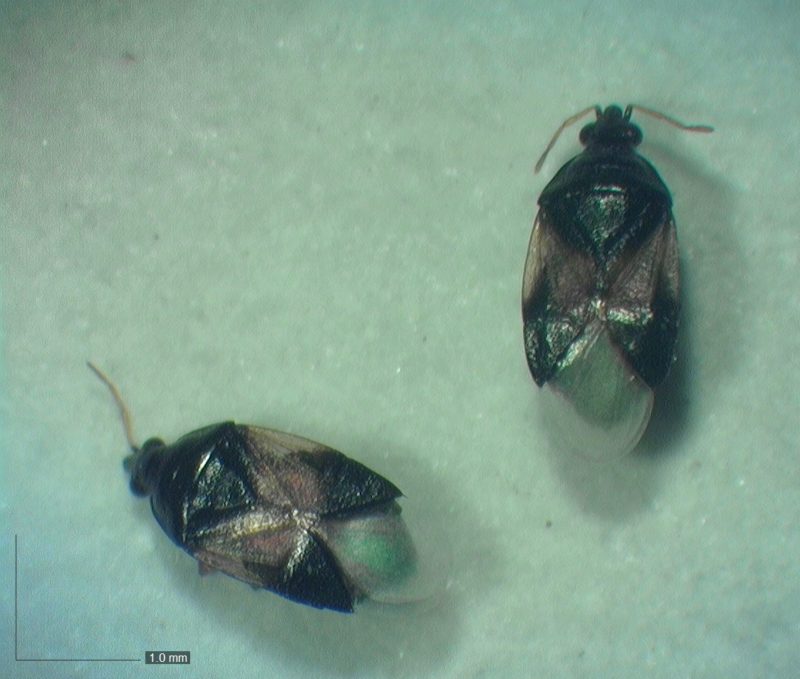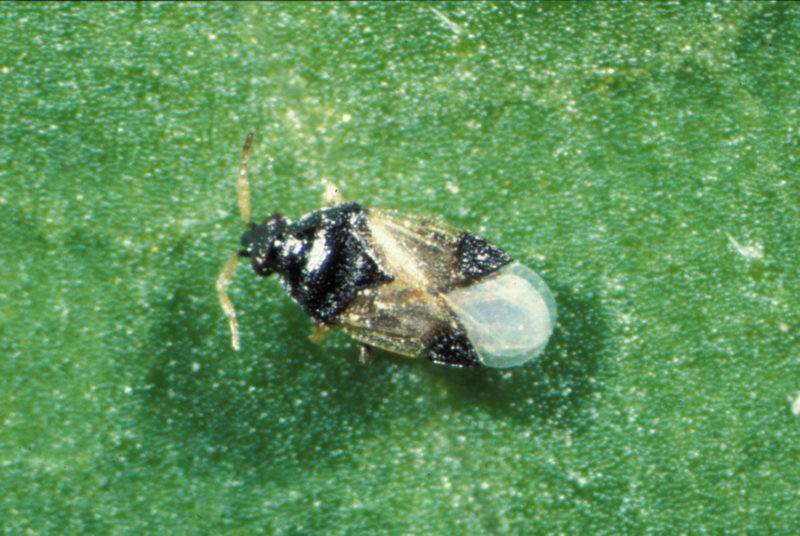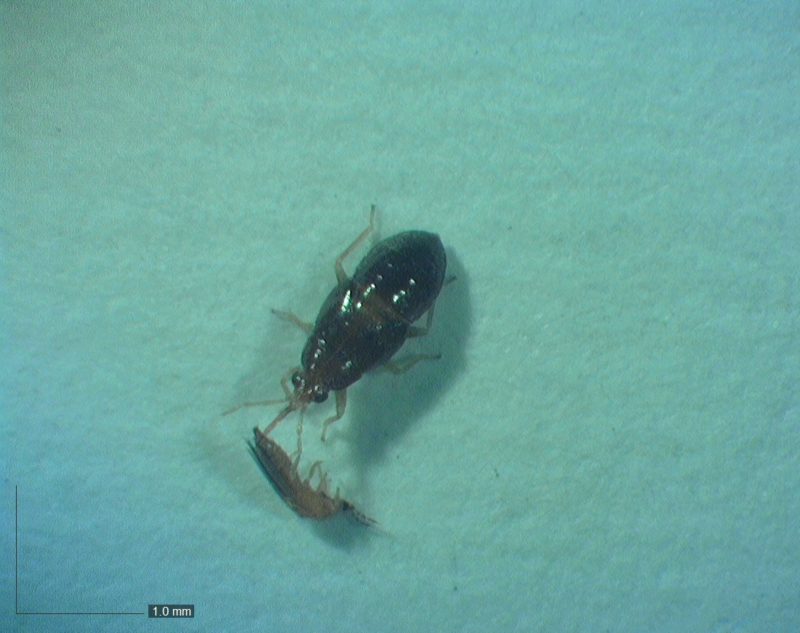Insidious Flower Bug
Question: Could you please provide information on the predatory bug, insidious flower bug?
Answer: Insidious flower bug, Orius insidiosus, adults are black, 2 to 5 mm long, and flattened with distinctively patterned black and white wings (Figures 1 and 2). Females insert eggs into plant tissues, such as stems and leaves, and nymphs emerge (eclose) from the eggs. Nymphs are light brown, 1 to 2 mm in length, teardrop shaped, with red eyes (Figure 3). There are five instars (immature stages). Both the nymphs and adults are predaceous.
The mean longevity of insidious flower bug adult females is 26.1 days under laboratory conditions. The insidious flower bug is commercially available from most biological control suppliers and is widely used to regulate insect pest populations in greenhouse production systems affiliated with vegetables and ornamentals. In addition, insidious flower bug is relatively easy to rear under laboratory conditions for mass production.

The insidious flower bug is a generalist predator with the nymphs and adults feeding on a wide range of insect and mite pests including: aphids, spider mites, thrips and whiteflies. Insidious flower bug can regulate populations of the western flower thrips, Frankliniella occidentalis, and two-spotted spider mite, Tetranychus urticae, when these two pests are present simultaneously. The insidious flower bug will feed on plant fluids, pollen and nectar in the absence of prey. The nymphs and adult life stages of the insidious flower bug feed on western flower thrips located on plant leaves and flowers. Studies have shown that insidious flower bugs can consume more than 20 western flower thrips per day.
Furthermore, the insidious flower bug can effectively regulate western flower thrips populations, either individually or when combined with other biological control agents. A benefit of releasing the insidious flower bug instead of the predatory mites, Neoseiulus cucumeris and Amblyseius swirskii, is that insidious flower bug nymphs and adults feed on the mobile life stages (larvae and adults) of the western flower thrips. The predatory mites only feed on the first instars of western flower thrips. The insidious flower bug can effectively regulate western flower thrips populations in ornamental and vegetable crop production systems. After insidious flower bugs are released as adults, the nymphs that emerge from the eggs are restricted to plants because they cannot fly. Consequently, the nymphs may provide additional regulation by feeding on western flower thrips (Figure 4).

The insidious flower bug was initially thought to undergo a reproductive diapause in response to short (<12 hours) day lengths or photoperiods, which would influence the ability of the insidious flower bug to effectively regulate western flower thrips populations from September through March. However, recent research in our laboratory at Kansas State University has demonstrated that insidious flower bug predation and female reproduction are not affected by short- or long-day lengths or photoperiods over the length of time required to produce a crop. Therefore, greenhouse producers can release insidious flower bug adults anytime during the growing season, even from fall through winter.
Banker plant systems consist of non-crop plants, which provide alternate food sources (prey) for predators, as well as nectar that enhance establishment. ‘Black Pearl’ pepper, Capsicum annuum, plants provide sufficient nectar and pollen that enhances development, fitness, and abundance of insidious flower bug adults.
However, the highest population growth of insidious flower bug occurs on ‘Purple Flash’ pepper plants, which suggests that ‘Purple Flash’ may be a more suitable banker plant for use in greenhouses. The use of banker plants may improve the effectiveness of insidious flower bug when used in biological control programs designed to regulate western flower thrips populations.

Plant type may affect the ability of insidious flower bug nymphs and adults to sufficiently regulate insect and mite pest populations. For example, insidious flower bug does not establish on tomato, Solanum lycopersicum, plants, which results in minimal regulation of western flower thrips populations. The reason may be associated with searching or foraging behavior being hindered by glandular trichomes (hairs) on the leaves and stem of tomato plants, which may inhibit the ability of the insidious flower bug to effectively regulate insect or mite pest populations.
The insidious flower bug is a commercially available generalist predator that effectively regulates populations of western flower thrips. Therefore, greenhouse producers should consider releasing insidious flower bugs into greenhouse production systems as a component of a biological control program.



 Video Library
Video Library 




















